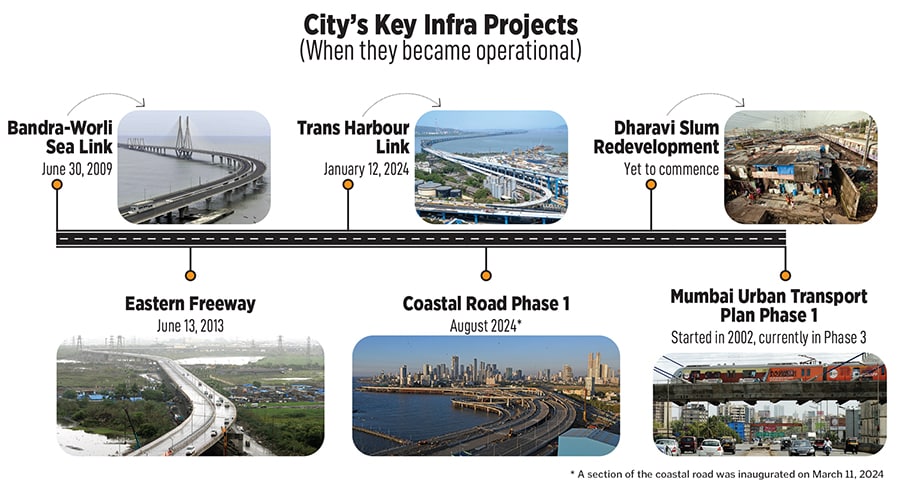Mumbai's Infra: From the Sea Link to the Coastal Road
In 2009, the Bandra-Worli Sea Link heralded the start of several infrastructure projects in the financial capital


In the early 2000s, driving from Bandra to the southern parts of Mumbai was at least a 30-minute struggle. That changed in 2009 when the Bandra-Worli Sea Link brought the suburbs closer to the city. It now takes just 10 minutes to get from Bandra to Worli.
Fast forward 15 years and it’s clear that the 5.6 kilometre-long cable-stayed bridge heralded the start of a new era of infrastructure projects in the city. These projects that span roadworks, the rail network as well as slum redevelopment took time to plan and execute and have, in the years to come, the potential to remake the city.
Since then, there have been upgrades to the city’s road network. The Eastern Freeway has been operational since 2013 and has cut down the travel time from the eastern suburbs to the city. More recent additions include the Mumbai Trans Harbour Link connecting Sewri to Nava Sheva. Both these will most likely be overshadowed by the grandest project of them all—the first phase of the Coastal Road connecting Marine Drive to the Bandra-Worli Sea Link. The total cost for all three projects: ₹26,000 crore.
The road works have provided a fillip to real estate projects located on its periphery. For instance, in Ulwe in Navi Mumbai, real estate prices are up from about ₹6,000 a square feet to ₹11,000 in the last decade. Buyers have factored in both the increased connectivity from the Trans Harbour Link as well as the Navi Mumbai airport.
“A key change between now and say, when the Bandra Worli Sea Link was completed, is that earlier, people never thought these projects would get completed on time. Now, the moment a project is announced or when construction starts, real estate project pricing in the vicinity starts factoring in that immediately," says Vishal Bhargava, a real estate columnist.

He believes that most areas in Mumbai have already factored in these infrastructure projects in their price except for areas north of Kandivali—the northern-most tip of the second phase of the Coastal Road.
Another component of Mumbai’s transport infrastructure that has seen a boost is urban transport. Through the Mumbai Urban Transport Plan, train lines have been upgraded, traffic signalling systems installed, and air-conditioned buses procured. The three-phase project started in 2002, but phases two and three, where a majority of the upgrades happened were launched in 2011 and were funded by the World Bank, the Asian Development Bank and the government.
Last are slum redevelopment projects that have the potential to transform the city’s skyline. The largest is the Dharavi redevelopment project as well as the smaller BDD Chawal redevelopment project. Both are located in central Mumbai and expected to free up space for both commercial and residential developments.
The Dharavi project—a joint venture between the Adani Group and the Government of Maharashtra—is scheduled to be completed in seven years at a cost of $3 billion (₹25,100 crore). While details on the amount of space it will free up on the 259-hectare area is unclear, it is expected to bring in significant supply of commercial and residential space in central Mumbai.
While the state government has been proactive in announcing projects over the last decade, what remains to be seen is how much they will be used. In fact, they may turn out to be financially unviable from a long-term perspective. The Eastern Freeway and Coastal Road phase one are toll free, but usage on the Trans Harbour Link saw a ridership of 0.8 million vehicles in the first month. This was partly on account of the steep toll fees of ₹250 one way. This number was 62 percent less than projections and saw collections of ₹13.95 crore in toll. The next round of project announcements would depend on how the first lot do.
First Published: May 27, 2024, 12:10
Subscribe Now